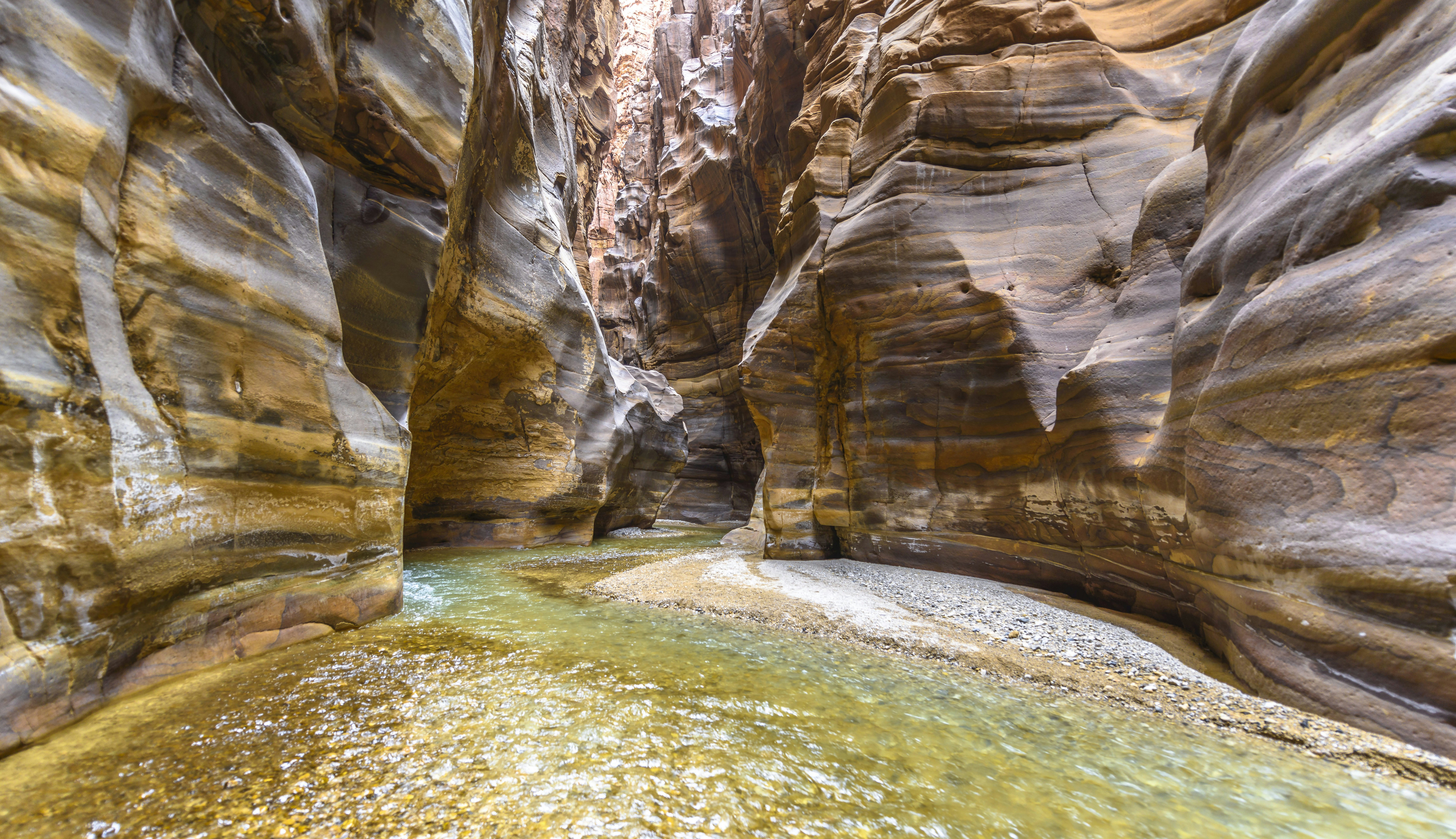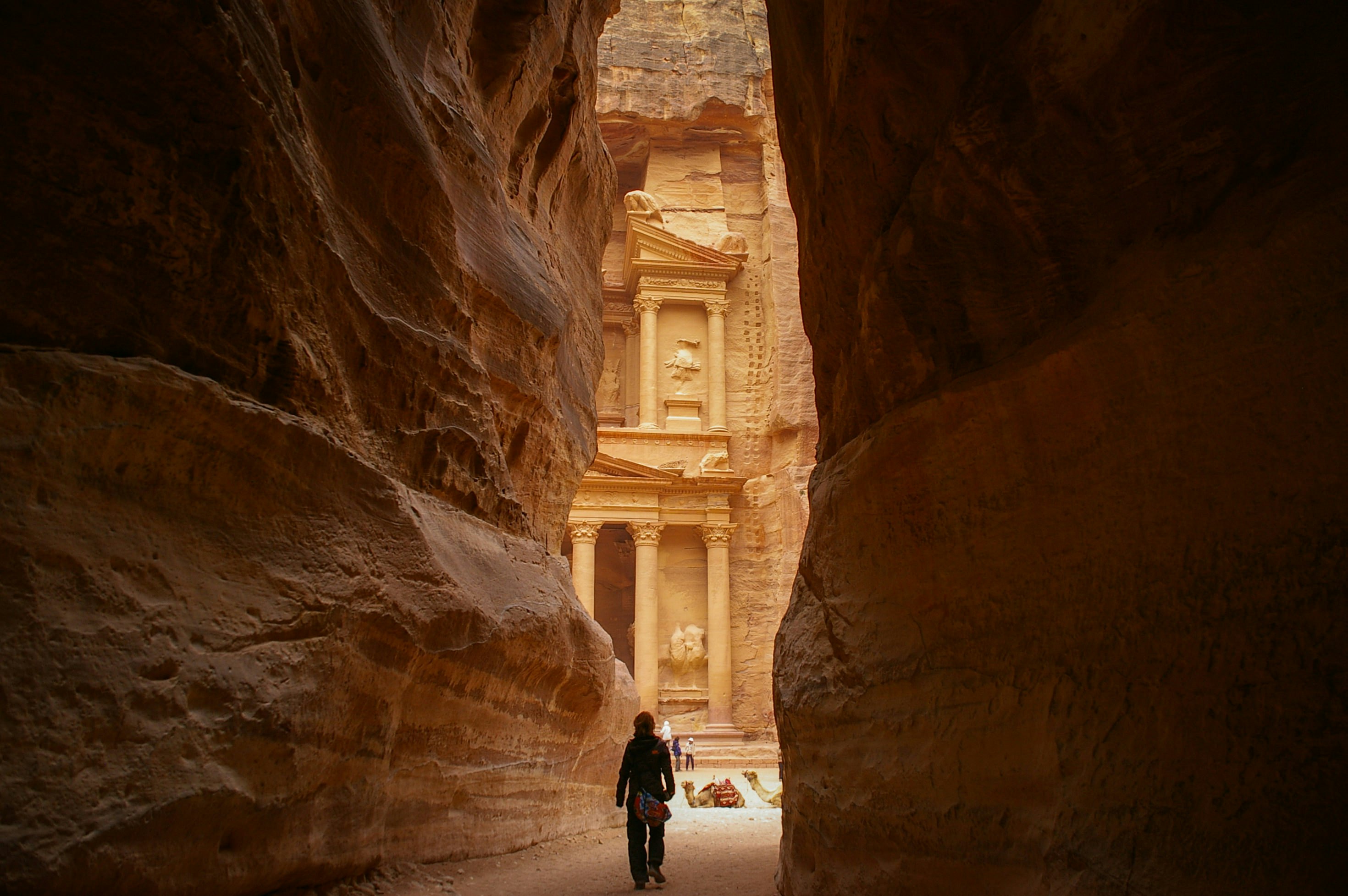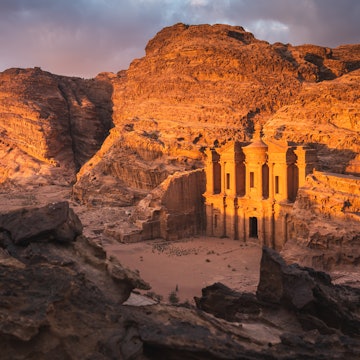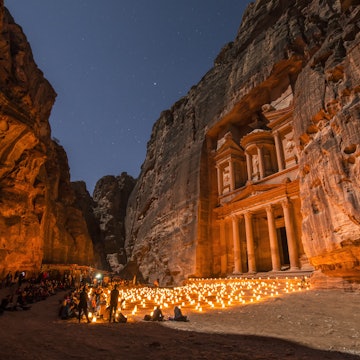
The 7 best hikes in Jordan explore deserts, wadis and world wonders

Nov 7, 2022 • 11 min read

It pays to be prepared when hiking into desert environments such as Wadi Rum © Anastasiia Shavshyna / Getty Images
Hiking in the desert is one of life's most meaningful experiences, serving up incomparable views you can’t see from your car, shared campfire meals with people you meet along the way, and silence and wide-open spaces for mindful reflection and late-night storytelling under the stars. Needless to say, hiking in Jordan – amongst fields of wildflowers, ancient sites, rugged mountains and out-of-this-world desert scapes – takes things to the next level.
Whether you have your heart set on the timeless ruins of Petra or the Dune-like landscapes of Wadi Rum, here is our pick of the best hikes in Jordan, from north to south.
1. Umm Qais to Ajloun
Best hike for forests and wildflowers
80km (50 miles) one way, 2-4 days, easy to moderate
Bookended by ancient ruins, this multiday hike from Umm Qais to the Ajloun Forest Reserve delivers the best of northern Jordan. An easy but rewarding trail leads walkers from the northern city of Umm Qais and the Greco-Roman ruins of Gadara through green forests and grassy fields to Ajloun Castle, built as part of Saladin's defenses against the Crusades.
Tackle this trail in the springtime, and you'll be rewarded by a sea of black irises and other wildflowers that bloom from March through April. If you have the fortune of meeting locals along the way, you might also get the chance to enjoy a handful of loz (almonds) picked fresh from the trees. The full route takes several days, with overnight stays at campsites or local homestays, but shorter day hikes around Umm Qais and Ajloun are possible for beginners, families with children or those short on time.
Top tip for hiking around Umm Qais: Before you hit the trails, tour the ruins of Gadara to gain some cultural and historical context and admire the unbelievable views over the surrounding hillsides. We recommend local guide Ahmad Alomari for a trip full of personal stories and insights into the ancient history of Umm Qais, plus some foraging along the way.

2. Wadi Mujib Canyon Trail
Best canyon hike near Amman
8km (5 miles) round trip, 4 hours, moderate to challenging
An easy day trip from Amman (or an overnight trip from one of the nearby Dead Sea hotels), Wadi Mujib is a refreshing escape from the desert heat. About 1.5 hours from the capital, this dramatic gully is lovingly labeled the “Grand Canyon of Jordan” for its colorful sandstone cliffs.
Although it’s possible to take easy self-guided hikes along the 3km (1.9-mile) Wadi Mujib Siq Trail, the real adventures take place on the longer Canyon Trail, where you’ll trek, wade, climb, slide and splash your way along the gorge with a Royal Society for the Conservation of Nature (RSCN) guide.
This hike involves canyoning techniques, such as crossing fast-moving water and slippery rocks, so it’s an adults-only adventure (participants must be 18 years of age or older), and you'll need to be able to swim. Conditions can change with the weather, and flash flooding and winter closures are a risk, so call ahead to confirm that treks are running.
Travelers under 18 can make a splash at other canyons within a two-hour drive of Amman. We suggest Wadi Salaita, reached via a fairly flat, 3km (1.9-mile) hiking trail with natural water slides and some easy rappelling; book a guided tour with TREKS.
3. Wadi Al Hasa
Best hike in summer
24km (14.9 miles) one way, 2 days, easy to moderate
Summer temperatures in Jordan can exceed 38ºC (100ºF), so if you’re visiting during the hot summer months, you’ll want to include at least one wet wadi experience to help keep you cool. Nader Manaseer, founder of Eco Hikers, recommends Wadi Al Hasa, located in the southern part of the Dead Sea region about two hours from Amman. This valley is Jordan’s longest wadi (river valley) – and its most beautiful, according to many locals – with gorge-ous cliffs, natural pools and hanging gardens.
No ropes are required for this hike, but it is more than a simple walk in the (water) park. The river flowing through the gorge can get deep, and depending on the weather, the current can be strong, so it's best to hike with a guide. Keep an eye out for fish swimming by, and bring a waterproof camera to capture the incredible rock formations you’ll spot along the way.
If you don’t have two days for the entire trail, it’s also possible to experience Wadi Al Hasa as a day trip from Amman; just keep an eye on the time and head back the way you came when you’re halfway through your available time.
4. Dana to Petra
Best hike for incredible views
76km (47 miles) one way, 4-9 days, moderate to challenging
Following Bedouin footpaths, the multi-day hike between Dana and Petra is one of the most beloved sections of the Jordan Trail, and it’s easy to see why. The varied terrain along the trail means that the scenery changes frequently, and you'll get a rich taste of Jordan’s ecology and history as you work your way from the country’s largest nature reserve toward the ancient city of Petra.
The trail stretches from the heights of Dana Biosphere Reserve (the only reserve in Jordan that includes four bioclimatic zones), descends into valleys and rises up again onto mountain ridges, culminating at Petra – a city carved from sandstone, a Unesco World Heritage Site and one of the New Seven Wonders of the World. “As many times as I hike this trek, it will always be my favorite section on the Jordan Trail," enthuses Ahlam Serhan, an avid climber and adventure tour guide in Jordan. "No two days are alike. Each is unique in its own way.”
According to Bedouin guide and Petra native Mahmoud Bdoul, one of the best things about being out in this vast and rugged natural space is finding yourself slowing down to notice the smallest details – the sound of a lizard scurrying across the rocks, the feeling of wind on your neck, and the beauty of the innumerable colors and textures in the landscape.

5. Petra’s Siq
Best hike for families
1.2km (0.75 miles) one way, 30 minutes-1 hour, easy
Carved by both nature and the people of the ancient Nabatean civilization, the main approach route to the ancient city of Petra follows an easy, well-trodden trail, delivering a genuine "wow" moment as the ruins loom into view as you round the last corner. Although it’s tempting to race down the winding pathway known as Al Siq ("the shaft") to reach the iconic facade of the Treasury, the trail itself is also steeped in desert history. To get the best out of the experience, book a local guide through Experience Jordan or Engaging Cultures, who can share more of the ancient city’s storied past and point out manmade features and carvings en route.
With few elevation changes, this short trek is perfect for families with children who want to visit Petra but lack the patience and energy to explore the vast 264-sq-km (102-sq-mile) site fully. Travelers with mobility needs can also visit Petra via the Siq trail with the help of golf carts or be carried along the trail by donkeys or camels. You may notice that some of the animals used for transportation at Petra are mistreated; if you’re considering a donkey or camel ride, be sure to choose an animal that appears healthy and is led by an adult handler.
A word of warning: As in many other top tourist sites around the world, some of the would-be guides and animal handlers at Petra can be pushy and even dishonest. Avoid going off-trail alone, and always book your trip with a reputable tour operator. If you're unsure whether a guide is legit, reach out to a trusted authority such as the Jordan Tourism Board.
Top tip for hiking to Petra: Much of the ancient site at Petra is still shrouded in mystery, and only about 15% of the ancient city has been excavated. You'll get more from a trip if you hire a local guide with personal stories to tell, family history to share and a deep knowledge of the place who can guide you along lesser-known trails overlooked by the crowds.

6. Petra to Wadi Rum
Best hike to go off the beaten path
90km (55.9 miles) one way, 5 days, moderate to challenging
While many visitors include stops in both Petra and Wadi Rum, it’s the hike between the two that delivers some of Jordan's most memorable off-the-beaten-path experiences. Leave behind the crowds of Petra and pass through quiet canyons and the “colored valley” – a natural rock masterpiece where the multi-hued sandstone creates swirls and splashes that look as though they were painted purposely.
At the trek's finish, a sea of sand punctuated by towering buttes signals your arrival at Wadi Rum. Sink your toes into the sand when you arrive at the dunes on day four, giving your feet a chance to breathe and connect with the land. The expansive wilderness, star-filled skies and sheer silence of this humbling hike make it a must for intrepid travelers seeking a truly contemplative experience.
7. Jordan Trail
Best difficult hike in Jordan
More than 675km (419.4 miles) one way, 30-45 days, challenging
The Jordan Trail is the country’s ultimate hike. From the northern forests near Umm Qais to the Red Sea in the south, this epic, multi-week route passes through dozens of villages, visiting Unesco World Heritage Sites, ascending mountains and weaving its way along narrow wadis and across sand dunes. The Jordan Trail is more than a hike: it’s an immersive experience of Jordan through its tremendous terrain and the culture, cuisine, history, language and traditions of its people. If you don't have time for the whole route, consider hiking shorter sections.
Given the level of difficulty, long-term commitment, the lack of clear waymarkers in some areas and the limited availability of supplies along sections of the route, this is a trek for highly experienced hikers who are accustomed to hiking in desert conditions and navigating by GPS. If you require additional support, contact the Jordan Trail Association to arrange a guide and water and food drops, or you can join an organized group hike.

Tips for hiking in Jordan
Hiking is one of the best ways to experience Jordan, but this activity comes with some risks. Be mindful of the weather and seasons when planning your trip. Summer (May to September) can be scorching hot and dry in many parts of Jordan, while winter (November to February) can be cold and wet with occasional snowfall. During the colder months, or for any overnight hikes and hikes at higher elevations, always bring warm clothing.
Flash flooding is also a hazard in the spring, fall and winter. It can be particularly dangerous in river valleys, gorges and other low-lying areas, including Wadi Mujib, Wadi Al Hasa and trails near the Dead Sea. Always check the weather and call ahead to check conditions with organizations such as the RSCN or the Jordan Trail Association.
If you're hiking to a destination not managed by a local organization, check the local news and weather reports and seek advice from local people. If you can’t find concrete answers to questions about the route, follow the fallback guidance for hikers everywhere: “If in doubt, don’t go out.”
Here are some more tips for staying safe while hiking in the desert kingdom.
Pack smart: Bring adequate water, snacks, sunscreen and a first-aid kit in your backpack – even for a day hike – and make sure you carry (or rent) any necessary equipment, such as hiking poles or helmets for canyoning.
Bring practical footwear: The type of hiking shoes you need will depend on the hike. For example, sneakers are fine for a walk through the Siq at Petra, but to fully explore the site, you'll want lightweight hiking boots with good traction. On the other hand, if you’re spending a day in Wadi Mujib, you might be more comfortable in water shoes. Ask your tour operator for their advice.
Use a GPS: Not all trails in Jordan are marked clearly, and cell service is not always available, so if you’re not on a guided hike, you will need a GPS device to find your way. Always let someone know where you are going and when you'll be back.
Consider hiring a local guide: While guides aren't needed for every hike in Jordan, hiring a local guide has numerous benefits, including local knowledge, cultural insights and helping you to stay safe on the trails. A guide can help you navigate unmarked turns, provide emergency first-aid and act as a translator if you get into trouble. Booking local guides also puts tourism money directly back into the local economy. Remember to book with a reputable guide or tour operator; if you’re uncertain, check with the Jordan Tourism Board, on-site visitor centers or the Jordan Trail Association.
Carry out whatever you carry in: Littering is a big issue in Jordan, and unfortunately, you will find trash scattered in even the most remote places. Do your part to keep Jordan’s trails clean by carrying out your trash, or join an Eco Hikers trip and be part of the “clean as we hike” club.
Be aware of wildlife and aggressive dogs: Jordan has snakes and scorpions, so be watchful of these creatures when walking, sitting and sleeping. It’s also likely you will meet dogs (typically guarding sheep, goats or property) while out hiking in Jordan, and these animals can be aggressive. If the shepherd or owner is nearby, they will often call the dog back. Otherwise, if no owner is in sight, you may need to pick up a rock and gesture as if throwing it while you move away.
Keep emergency numbers to hand: The Jordan tourism police hotline is 117777, or you can reach them via WhatsApp at +962 7 7099 1814. For anyone hiking the Jordan Trail, the phone number for the Jordan Trail office is +962 6461 0999.















